|
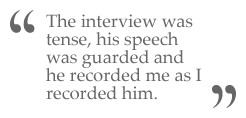 After I had interviewed several gay Catholics and the leader of Peace and
Justice (Sister Marge O’Gorman), I realized that I had to find someone who could
set the stage of the documentary by laying out the official Church doctrine on
homosexuality. This proved to be a complicated process of dealing with Catholic
bureaucracy from the Archbishop down to the ostensibly heterosexual Father James
Knapp, the leader of Courage (the official Catholic Group for people with
homosexual tendencies). While I was attempting to get an interview from someone
inside the Church about the doctrine, I had to be very careful to not draw too
much attention to some of the other organizations and people I had already been
in contact with. I did not want to cause the gay friendly organizations to be
shut down. Eventually, I was granted an official Archbishop sanctioned interview
with Father Knapp. The interview was tense, his speech was guarded and he
recorded me as I recorded him. After I had interviewed several gay Catholics and the leader of Peace and
Justice (Sister Marge O’Gorman), I realized that I had to find someone who could
set the stage of the documentary by laying out the official Church doctrine on
homosexuality. This proved to be a complicated process of dealing with Catholic
bureaucracy from the Archbishop down to the ostensibly heterosexual Father James
Knapp, the leader of Courage (the official Catholic Group for people with
homosexual tendencies). While I was attempting to get an interview from someone
inside the Church about the doctrine, I had to be very careful to not draw too
much attention to some of the other organizations and people I had already been
in contact with. I did not want to cause the gay friendly organizations to be
shut down. Eventually, I was granted an official Archbishop sanctioned interview
with Father Knapp. The interview was tense, his speech was guarded and he
recorded me as I recorded him.
“A Place at the Table” runs approximately ten minutes and is comprised of
interviews shot in the interviewee’s personal spaces such as, a home or place of
worship. They are linked together with symbolic footage of Catholic imagery,
mostly taken from the Cathedral Basilica of Saint Louis and the Saint Francis
Xavier College Church. This documentary addresses the Church’s doctrine in
contrast to the actual experience of living as a homosexual in the Church.
After working closely with the gay Catholic community, I wanted to return to
working with ideas of gender, experience and the body. I also felt it was time
for me to work more directly from personal experiences.
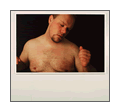  At age 14, I underwent a double mastectomy as a result of gynocomastia, a
disorder in some boys that results in the formation of breasts at puberty. The
surgery left me with large scars across my chest and around my nipples. These
scars represent my own painful experience with non-normative gender. These
photographs attempt to take control back over my body in a way that celebrated
that experience while acknowledging the pain. At age 14, I underwent a double mastectomy as a result of gynocomastia, a
disorder in some boys that results in the formation of breasts at puberty. The
surgery left me with large scars across my chest and around my nipples. These
scars represent my own painful experience with non-normative gender. These
photographs attempt to take control back over my body in a way that celebrated
that experience while acknowledging the pain.
Out of the images I had, I found one that struck me; my eyes were closed, my
expression a mix between ecstasy and pain – my gesture dynamic. I wanted to
highlight the gesture and emotion while emphasizing the scars. I came to the
idea of sewing red thread into the image over the scars to
accentuate the emotional consequences of the
surgery. During the process of sewing I noticed that the gesture in the
photograph was similar to the action I was making. This realization caused me to
connect the thread to my hand in the image. The thread and image seemed to
visually merge into each other.
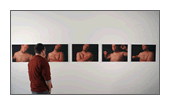  For the final presentation of what came to be known as “Sewing the Façade” I
chose five images, printed them life-size on matte finished paper and sewed into
them with red thread. On some of the images I sewed strictly over the scars from
my surgery and in others I responded less literally to the image. All of the
images are of me from the mid-torso up, on a black background, with my eyes
closed. The thread is sewn into my chest at various locations and connects to my
hands to make it appear as if the image is sewing itself. I left the needle on
the thread dangling outside the frame to further the illusion and to break the
frame of the picture. The use of red thread and the inclusion of the needle is
of particular importance to the work. They are meant to be read beyond the
literal reference of blood and surgery, to be healing yet destructive,
concealing while highlighting, masculine and feminine. These elements get to the
core of what I want “Sewing the Façade” to visually articulate. For the final presentation of what came to be known as “Sewing the Façade” I
chose five images, printed them life-size on matte finished paper and sewed into
them with red thread. On some of the images I sewed strictly over the scars from
my surgery and in others I responded less literally to the image. All of the
images are of me from the mid-torso up, on a black background, with my eyes
closed. The thread is sewn into my chest at various locations and connects to my
hands to make it appear as if the image is sewing itself. I left the needle on
the thread dangling outside the frame to further the illusion and to break the
frame of the picture. The use of red thread and the inclusion of the needle is
of particular importance to the work. They are meant to be read beyond the
literal reference of blood and surgery, to be healing yet destructive,
concealing while highlighting, masculine and feminine. These elements get to the
core of what I want “Sewing the Façade” to visually articulate.
“Sewing the Façade” addresses ideas surrounding the body in relationship to
self-expression, queerness and gender. It celebrates the beauty of the
non-normative while documenting the pain afflicted by the normative ideal.
 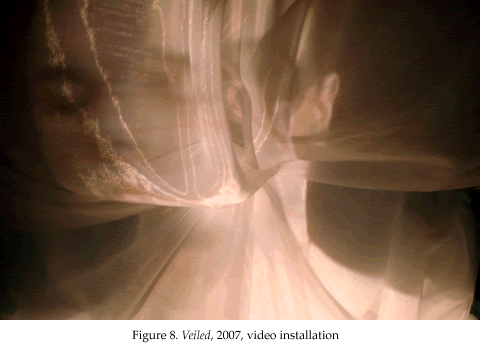 Most recently, I created the video installation “Veiled.” The work consists of
large amounts of various white fabrics suspended in the middle of a dark space
with a video projection coming from inside. The initial view is of a large
circular glowing white satin form. There is a part in the fabric that serves as
an entry revealing the inner part of the installation. Inside there is soft
gathered chiffon. From behind a single sheet of sheer fabric a video of myself
is projected in small scale. Since the fabric is sheer and the projection is
from behind, the flowing fabric lining the structure also has a larger less
sharp version of the video projected on it. The rear projection is also what
gives the exterior fabric a glow, even though no discernable image can be seen
from the outside... (continue reading) Most recently, I created the video installation “Veiled.” The work consists of
large amounts of various white fabrics suspended in the middle of a dark space
with a video projection coming from inside. The initial view is of a large
circular glowing white satin form. There is a part in the fabric that serves as
an entry revealing the inner part of the installation. Inside there is soft
gathered chiffon. From behind a single sheet of sheer fabric a video of myself
is projected in small scale. Since the fabric is sheer and the projection is
from behind, the flowing fabric lining the structure also has a larger less
sharp version of the video projected on it. The rear projection is also what
gives the exterior fabric a glow, even though no discernable image can be seen
from the outside... (continue reading)
| 
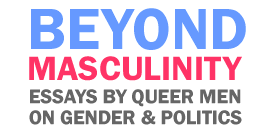


3 COMMENTS ON THIS ESSAY:
I love your art, especially the iconoclast images. Can I find them online elsewhere?
This type of art also highlights the similarities between devotion to religion and devotion to your partner, which I think is closer than a lot of people think.
simply stunning...:)
We are running a short feature of your art on www.redlimemagazine.com until Feb 4th
Your work is beautiful!